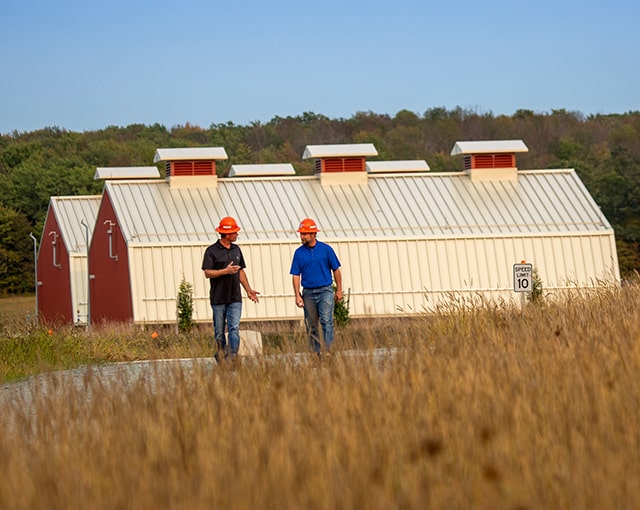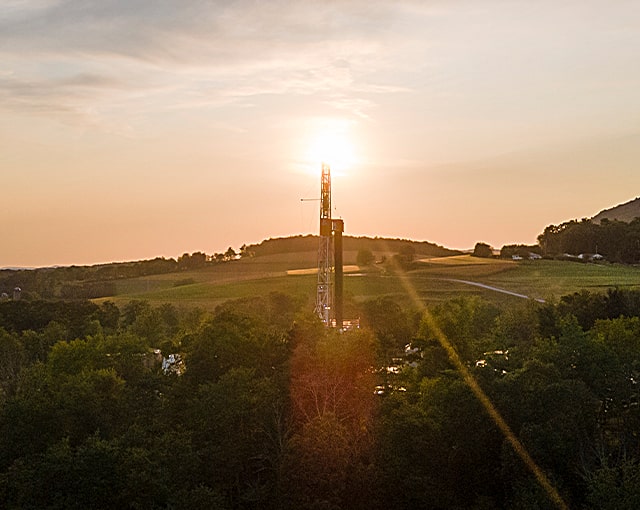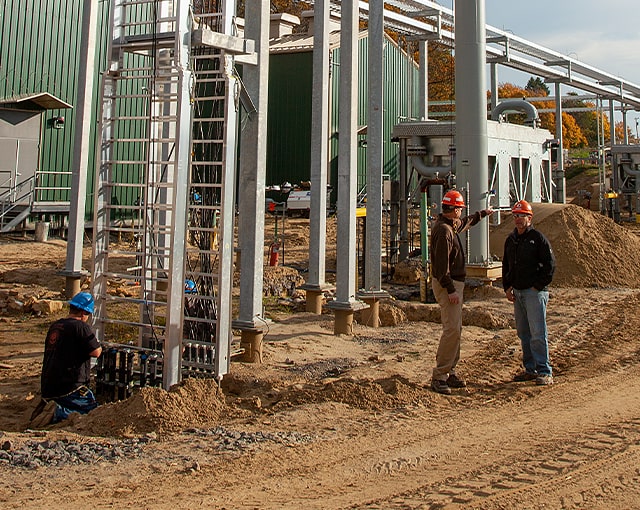Have a Gas Emergency?
Call 1-800-444-3130
24 Hours a Day
811 Call Before You Dig
Call 8-1-1 before you dig to have your utility lines marked for free.
NYSE: NFG
(Minimum 20 min. delay)
$55.27
$1.52
Volume 903,358
04/24/2024
4:00 PM
Our Commitment to the Environment
National Fuel understands that we have an obligation to ensure our operations have minimal impact on the environment and natural resources in and around our operating areas in New York and Pennsylvania. Consistent with our Environmental Policy Statement, National Fuel’s operating subsidiaries have developed and implemented procedures, technologies and best management practices to develop and operate our assets in a manner that respects and protects the environment, mitigate any potential adverse environmental impacts of our activities, and provide our employees and contractors with the necessary resources to ensure compliance with environmental regulations.
Exploration and Production
Protection and Conservation
Environmental protection and conservation of resources are high priorities across Seneca Resource Company, LLC’s drilling and completion operations. During initial planning and development, and throughout the producing life of a well, we go to great lengths to ensure our work has minimal impact on local water, land and wildlife resources. These initiatives include:
Planning and Permitting
Before we arrive on a development site, we conduct a thorough environmental, health and safety review and work with applicable federal, state and local government agencies to obtain all necessary environmental permits and approvals. These evaluations cover all aspects of environmental stewardship, ranging from threatened and endangered species to invasive species, to stormwater management and habitat restoration. Seneca Resources works with resource agencies as their partner, not simply as a regulated entity.
Get more information on Seneca Resources’ Regulatory Responsibilities.
Minimizing Surface Footprint
Our multi-well pad development practices allow us to maximize the natural gas reserves that we are able to access underground while minimizing the footprint required at the surface for our operations. We are often able to drill 10 or more wells from a single surface pad and extend the lateral length of our horizontal wells up to a mile and a half under the surface. Seneca Resources has extended this minimization to returning to existing Marcellus pads to drill additional wells into the Utica formation.
Protecting Freshwater Aquifers
Seneca collects pre-drilling water samples on any water source within a 4,000-foot radius from the center of the pad to obtain a baseline measurement. Seneca Resources’ horizontal drilling practices use only water-based drilling fluid or air when drilling through freshwater zones. During other stages of drilling, a synthetic oil-based mud system is used once freshwater zones are protected by casing and cement.
Zero Surface Discharge Policy
For all unconventional operations, Seneca Resources follows a strict “Zero Surface Discharge” policy, which requires containment for any liquids or solids that may be considered residual waste in all aspects of our operations, as a means of protecting surface and groundwater resources throughout the life of a well. All wastes are managed in primary containment vessels, which are always placed inside of secondary containment systems, and often tertiary containment, designed to capture and control spills or leaks.
Transparency with Chemical Disclosures
Seneca’s hydraulic fracturing fluids are in full compliance with both EPA and state regulations. Seneca voluntarily participates in FracFocus.org, an independent website that provides information to help stakeholders understand the additives in the water being used for all of Seneca’s shale development operations in Appalachia as well as oil operations in California. Seneca also voluntarily provides this data to the Pennsylvania Department of Environmental Protection.
Protecting Habitat Diversity
Seneca takes pride in enhancing marginal habitats in the areas in which we work through reclamation and planting strategies suggested by state and federal resource agencies, conservation organizations and private landowners. Seneca has been directly involved in restoration activities ranging from stream improvements to reseeding with native grasses.
Watershed Enhancement
Seneca has upgraded more than 150 miles of dirt and gravel roads with limestone running surfaces and constructs all drilling pads with limestone erosion and sedimentation controls. We have seen positive in-stream impacts with aquatic diversity from these watershed enhancement strategies through buffered in-stream pH values during storm events.
Threatened and Endangered Species
Seneca has worked with resource agencies in Pennsylvania to identify and cooperatively manage the protection of threatened and endangered species, as well as eradicating invasive plant species.
Learn more about the life of a natural gas well.
Water management
Seneca prides itself on being an industry leader in managing water assets. For calendar 2020, based on a survey of environmental performance conducted by the The American Exploration and Production Council (“AXPC”) – a national trade association representing the largest independent oil and natural gas exploration and production companies in the United States – Seneca Resources ranked 2nd best out of 22 companies for our recycled water rate.
Highland Field Services
In 2014, our Upstream Segment formed its own water logistics company, Highland Field Services, LLC (“Highland”), to manage the sourcing, handling and recycling of fluids generated by and used in its Appalachian operations. Since then, Highland has invested over $65 million in water infrastructure in Pennsylvania, including storage and treatment facilities, on-pad tanks and containment vessels, injection wells, and a network of water distribution pipelines. The environmental, operational and economic goals and achievements of Highland include:
- Recycle produced fluids—Seneca plans its development schedule and works closely with Highland and Seneca’s other third-party service companies to optimize Seneca’s ability to utilize recycled produced fluids. Highland also receives and recycles produced volumes generated from third-party operators who would otherwise need to transport their produced fluids for out-of-state disposal. In fiscal 2020, Highland recycled 96% of Seneca’s produced fluids, or 6.7 million barrels, plus an additional 440,000 barrels of fluids that were generated by and received from third-party operators.
- Minimize fresh water used in new well completions—Seneca’s ability to reuse recycled fluids in new well completions has significantly reduced the amount of freshwater consumed by our operations. In 2020, Seneca’s Marcellus and Utica shale well completions used 66% recycled fluids and only 34% freshwater. The freshwater consumed in our completions was sourced from Seneca-owned groundwater wells and permitted stream withdrawal locations.
- Reduce environmental footprint—Highland manages the movement of approximately 1.1 million barrels of fluid every month, more than 85% of which is pumped through Highland’s pipeline distribution system to deliver fluids from storage facilities directly to Seneca’s Marcellus and Utica development pads. As a result, Seneca was able to avoid an estimated 100,000 truck trips in fiscal 2020, eliminating the associated air emissions and reducing the impact on local roads and public infrastructure.
- Develop innovative, environmentally sound disposal solutions—While our goal is to recycle 100% of the produced fluids generated by Seneca’s production, it is important to have disposal capabilities available to cover any potential operational delays or other issues. As such, Seneca and Highland have been actively developing their own underground disposal well capabilities under an underground injection control (UIC) program designed to manage Seneca’s disposal needs in an environmentally sound manner, and currently have operating UIC wells in Pennsylvania and Ohio.
- Promote transparency and regulatory compliance—All fluid handled by Highland, including type, volume, origin and destination, is tracked for regulatory and internal reporting purposes. In Pennsylvania, we are required to report the fluid movement and usage in various forms including downhole volumes for well completion, incoming/outgoing loads at the storage facilities and pads, fluids utilized by third party operators, and freshwater storage levels across our operations.
- Lower fluids management costs—The environmental benefits derived from Highland’s efforts to recycle and avoid the disposal of produced fluids also results in significant economic benefits for Seneca and its third-party operator customers.



Pipeline and Facility Construction and Maintenance
For our gathering, pipeline, and storage and utility segments, environmental protection and conservation is a high priority throughout the planning, design, and construction and restoration of a pipeline and/or facility construction or maintenance project. We use modern construction and land restoration techniques and design our facilities to meet or exceed industry standards and environmental regulations.
Maintaining Compliance
We obtain all required permits prior to the commencement of construction and have implemented strong internal controls to remain in compliance with all environmental and safety requirements. Additionally, a number of federal, state and local regulatory agencies will frequently perform on-site inspections or otherwise monitor the project’s design, construction and ongoing operation. These agencies include:
- Federal Energy Regulatory Commission (FERC)
- Environmental Protection Agency (EPA)
- Pipeline and Hazardous Materials Safety Administration (PHMSA)
- New York Department of Environmental Conservation (NY DEC)
- Pennsylvania Department of Environmental Protection (PaDEP)
- New York Public Service Commission (NY PSC)
- Pennsylvania Public Utility Commission (PA PUC)
- New York State Department of Agriculture and Markets
Over the past three years, National Fuel’s pipeline and related facility construction projects have had over 190 official agency field inspections to verify our compliance with permit conditions, resulting in no significant findings or violations.
Minimizing Land Disturbance
When possible, we route new pipelines along existing rights of way and limit the area and duration of our construction workspace to minimize land disturbance, reduce tree clearing and preserve areas for landowner use.
Protection of Water Resources
Protection of surface and groundwater resources is of the utmost importance to us. We minimize our impact by using effective, proven construction best management practices and protective waterbody crossing methods. These plans are closely followed and continuously monitored by National Fuel environmental inspectors and contractors, and routinely inspected by federal and state regulatory agencies.
Protection of Vegetation and Wildlife
We have implemented a number of practices designed to protect identified threatened and endangered species, including the restriction of construction activities during specific time frames and the restoration and sometimes recreation of habitats. Endangered plants are transplanted to nearby areas and then replanted on the restored right of way. We also use native, specialized seed mixes during replanting to prevent erosion and sedimentation, enhance wildlife foraging areas, promote native insect species pollination and to re-establish native wetland species. Additionally, National Fuel has enrolled in the Nationwide Candidate Conservation Agreement with Assurances (CCAA). 16,000 acres are included as enrolled lands. The intent of the CCAA is to enhance and expand available monarch butterfly habitats through conservation measures.
Protection of Farmland and Soils
When agricultural land is identified along a pipeline route, we will use specialized construction techniques to preserve and restore the topsoil. We work closely with the farmers during revegetation efforts, using soil decompaction and soil additives to provide a proper seedbed to facilitate lodging and germination of seed. Care is taken to ensure that field drain tile systems maintain their functionality and are kept in good working condition. Revegetation is monitored until crop growth and vigor are similar to adjacent undisturbed portions of the same field.
Protection of Cultural Resources
We are sensitive to the archeological preservation of historic artifacts (areas with archaeological significance and historic buildings). We work frequently with applicable state and tribal historic preservation offices to identify and develop protective measures to be used prior to and during construction activities.
Minimizing Impacts on Local Communities
We’re committed to being a good neighbor and working with local communities to address noise, visual and emissions concerns. We design and/or test all audible components to ensure facility noise levels are less than regulatory mandates. We employ civil engineering and architectural practices to lessen visual impact and use equipment and technologies that ensure emission performance meet or exceeds regulatory standards.
Proper Handling and Disposal of Wastes
We have developed waste minimization and spill contingency plans in accordance with environmental regulations. We take great care to educate and train our employees in the proper handling, staging and preparation of regulated wastes and materials for disposal.
